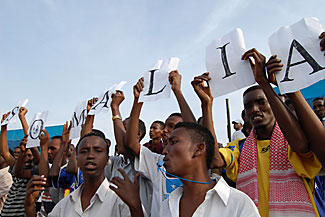|
(Kambala. March 05, 2009 Ceegaag Online)
The
national team unites a scattered diaspora and provides a
reason to cheer for war-torn Somalia.

FANS FROM AFAR: Somali soccer
supporters cheer for the national team during the East
African CECAFA tournament in Kampala, Uganda, Jan. 7. Almost
half of the team's players live outside Somalia.
For all of his adult life, Ahmed Mohamed Farah has only
seen the country he represents in news footage of war,
killings, and starvation. Now studying for a business degree
at Carleton University in Ottawa, Mr. Farah says it was a
strange feeling the first time he pulled on the national
soccer jersey of his distant homeland: Somalia.
  
Fourteen years ago, Farah and his family fled the
spiraling fighting in Somalia, heading to the Middle East
before ending up in Canada. After being spotted by scouts at
a Somali football tournament in Toronto last year, he was
tapped to play for the national team – nicknamed the Ocean
Stars – in a recent regional championship in Uganda. But he
won't be heading back to Somalia anytime soon.
Better known for the film "Black Hawk Down," a ferocious
Islamist insurgency, and piracy, Somalia has been dubbed the
most dangerous place in the world. It has only a weak,
ineffectual transitional government and no functioning
state, and it has been more than 20 years since the national
team has been able to play a match in the country. In the
war-ravaged capital Mogadishu, Islamist rebel groups battle
African Union peacekeeping forces – and each other.
Somalia's national league has been suspended for years now.
In these conditions, it is a miracle that the country still
has a soccer team.

But soccer – or just the existence of the national team –
has become a focus for hope in this shattered nation and the
country's huge diaspora around the world. At the regional
CECAFA East African soccer championship in Uganda in
January, hundreds of Somali fans formed a backdrop of
constant noise and color. Setting tribal differences aside,
men bounced up and down in the deep blue colors of the
national team. Women had turned the national flag into the
traditional dress of headscarves and flowing dirac
robes.
"We have waited such a long time to see our flag raised
and have our anthem sung in front of us. Even though we are
not in our country, our hearts are big for the team," says
Ali Abdirahman Warsame, who left Somalia for Uganda as a
toddler. "Football is like a religion – it unites us."
Despite the support in the stands, Somali football is
desperately short of funding. Because of the situation in
their homeland, the team has had to shift training to
neighboring countries. "Before this tournament, we were
training in Djibouti," says long-time national coach Ali
Abdi Farah, who still lives in Mogadishu. "Djibouti is now
our home stadium."
Given the hardships they face off the field, it is hardly
surprising that the Somali team languishes in the bottom 10
of Fifa's world soccer rankings. Like Farah from Canada, an
increasing number of players are being drawn from Somali
communities around the world. Now almost half the squad
lives outside Somalia. They come from communities in the US,
Canada, Britain, and Norway.
For the Somali players, international soccer is rarely as
glamorous as it is made out to be. The foreign-based players
had to cover the cost of their airfares to get to the CECAFA
tournament. Once there, they had to wash their own uniforms.
But things could be looking up for the Somali team.
Despite crashing out in the group stages of the East African
tournament, they recorded their first victory in five years,
beating local giants Tanzania 1-0. With a young, united
team, soccer could help bring this broken nation together,
says team captain Isse Abshir, who plays for Norwegian team
Lillestrom.
"It was incredible, the congratulations from all over the
world that we received when we beat Tanzania," Mr. Abshir
says. "This is the real government of Somalia – the football
team. This is the image that we have to show the world."
Source: The Christian Science Monitor
www.ceegaag.com

webmaster@ceegaag.com |

